15 Piranha
Rick Bein
Men should Never Swim with Piranha without a Swimming Suit!
Piranhas in South American rivers perform a job for the environment by keeping the rivers clean of organic material. While known for their meat-eating habits, not all of the dozen or more species of piranha eat flesh. Some species of piranhas are vegetarian and consume fruits and leaves that fall into the rivers.
My Peace Corps (1964) experience with piranhas came after an extensive all-day trip from the Campo Cerrado down onto the Pantanal of western Brazil. A settler and his family were being taken out to the Taquari River to where they would be sequestered once the rainy season was in full force. My Peace Corps buddy and I accepted the offer and joined the group.
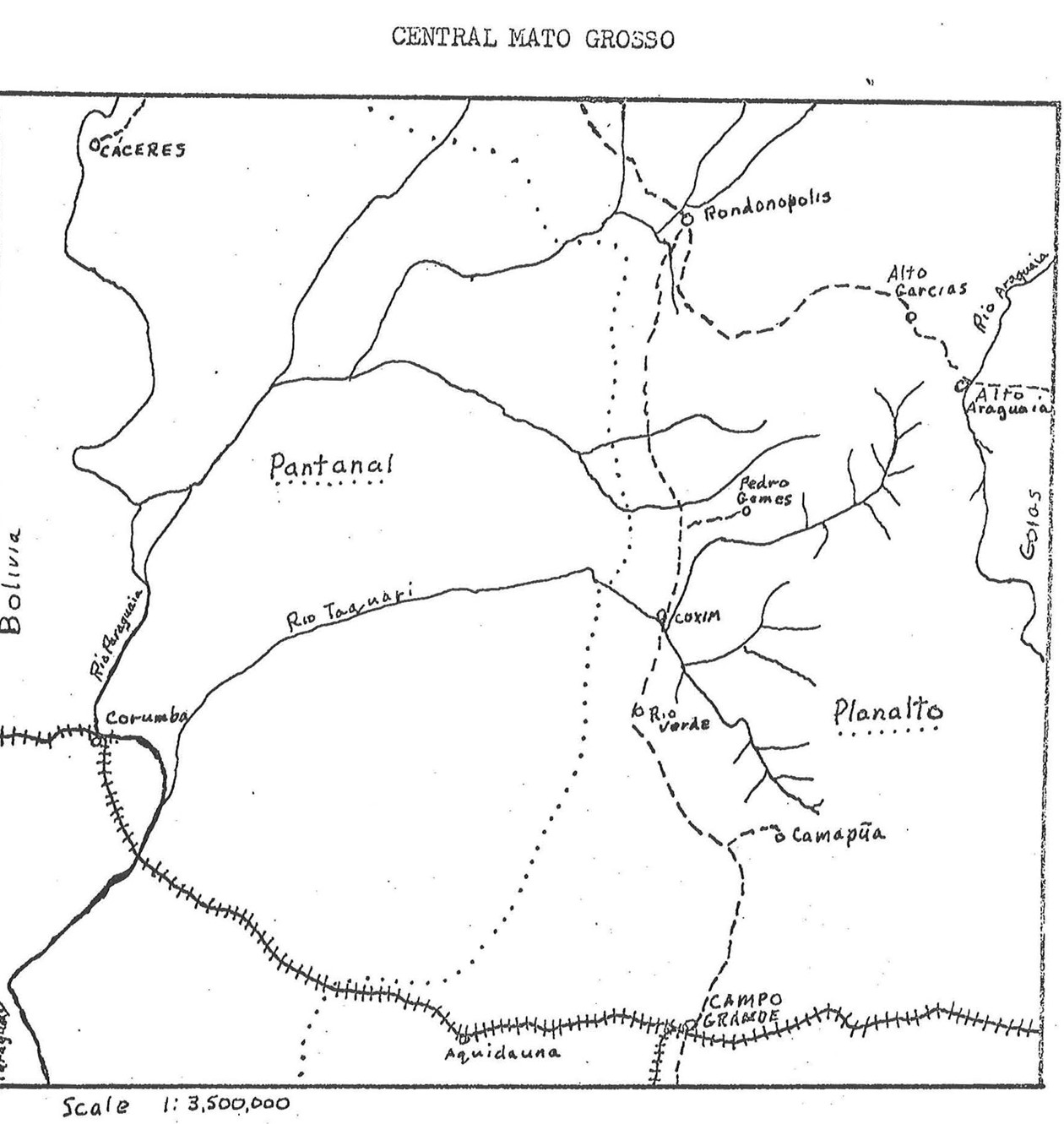
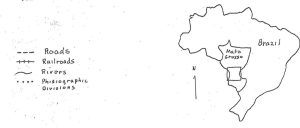
Hand-drawn map by Rick Bein, 1966, showing the towns of central Mato Grosso do Sul with the Pantanal on the left side.
0____________200 miles
The Pantanal of western Brazil is one of the world’s largest unique wetlands. Most of the seventy-thousand-square-mile area (about the size of North Dakota) is owned by approximately thirty ranchers who use it mostly for dry-season cattle grazing and recreation. During the rainy season, this vast flat lowland floods from all the surrounding swollen rivers. It is only one hundred meters above sea level, yet it is two thousand kilometers from the sea. The Paraguay River slowly drains the Pantanal each year, taking the water south to meet the Paraná River, which flows into the La Plata River before dumping into the Atlantic Ocean.
The Pantanal has one of the most unique biotopes. A number of swamp plants have evolved very differently here from similar environments around the world. Among the fauna are a number of unique species pictured below. Some are shared with the Amazon Basin, such as the Piranha. The largest rodent on the earth, the capybara, is found here, a flightless bird unique to Brazil, the ema, the peccary, the anaconda, and many more.
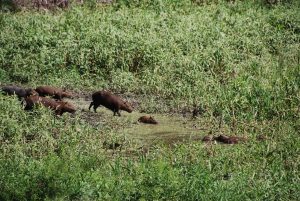 The Pantanal – Passeo de Longes Camp – Capybaras (Hydrochoerus hydrochaeris), the largest rodent on the planet. Photo by KThomasson is licensed under CC BY-NC-ND 2.0.
The Pantanal – Passeo de Longes Camp – Capybaras (Hydrochoerus hydrochaeris), the largest rodent on the planet. Photo by KThomasson is licensed under CC BY-NC-ND 2.0.
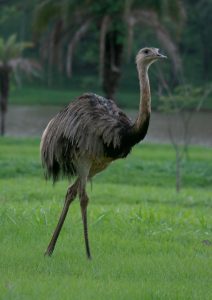
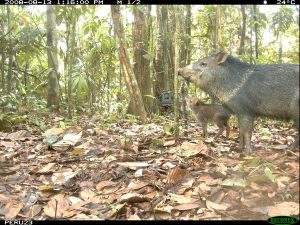
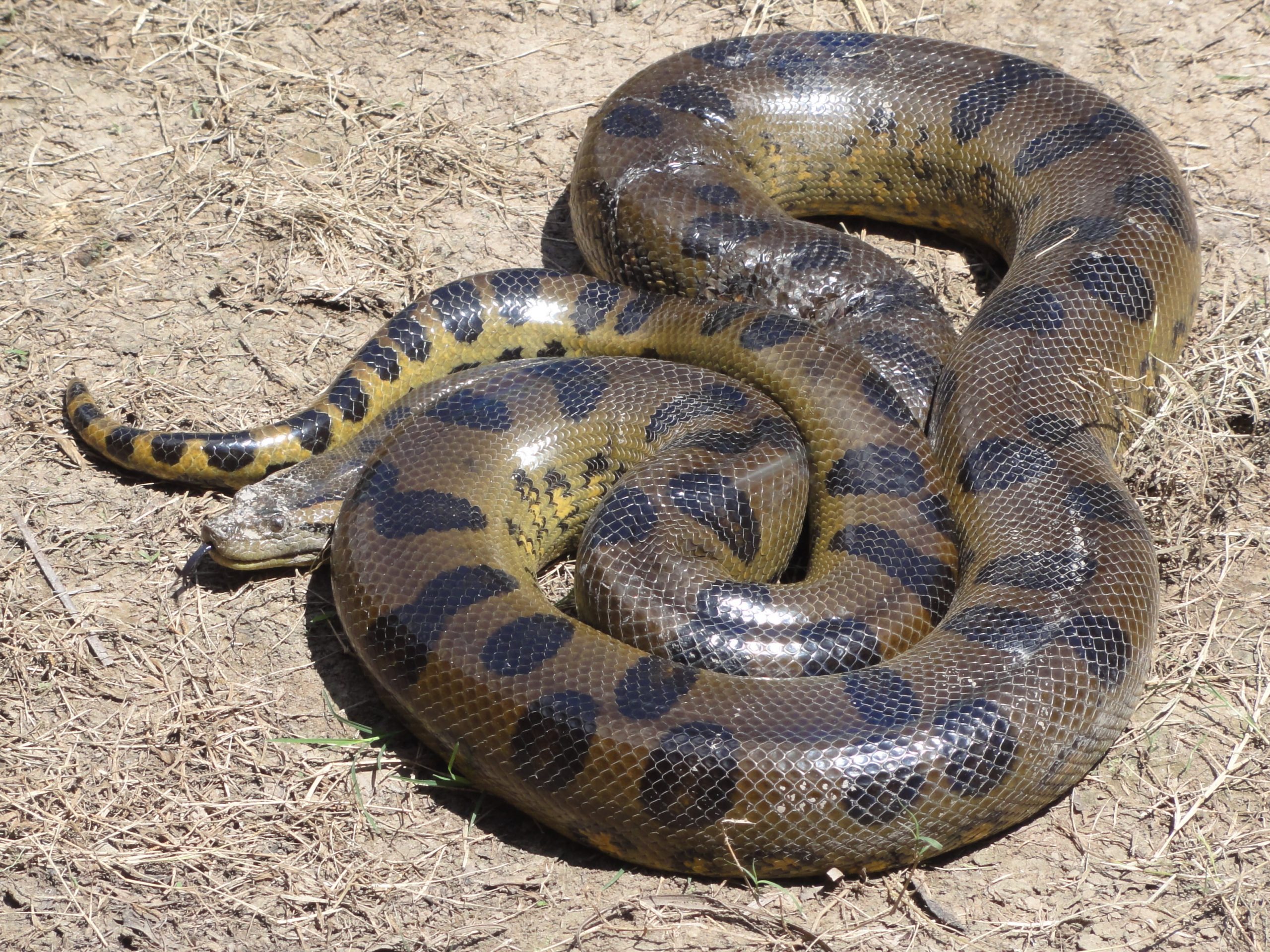
Ema ( Rhea Americana) by Wagner Machado Carlos Lemes is licensed under CC BY 2.0
Collared Peccary (Pecari tajacu) by Smithsonian’s National Zoo is licensed free under CC BY-NC-ND 2.0 2008
Anaconda_Loreto_Peru httpsupload. wikimedia.orgwikipediacommons2009
It was the beginning of the rainy season and the last opportunity to move the family before the Pantanal became completely flooded. Half a dozen of us crowded in among all of their furniture, plus the food and supplies that were loaded onto the open truck.
After leaving the main road and starting down onto the Pantanal, someone discovered the case of Cachaca bottles hidden under some of the family’s belongings. A lid came off, and the bottled alcohol was passed around. Eventually, some bottles ended up in the truck cab! A short time later, the driver became inebriated and several times ran the truck into the mud several times! Each time, everyone climbed down and helped push the truck back on the road.
Cachaca (pronounced Kashasa) is distilled from sugar cane, resulting in a cheap but strong alcohol available throughout Brazil. Decades ago, it was discovered that it could also be used as an emergency fuel for automobiles! Since then, it has been refined and used as a vehicle fuel to avert the world petroleum crises that began in the 1980s. Today, Brazil is petroleum independent and arguably the world leader in ethanol production.
About an hour before dusk, we finally arrived at the ranch house on a levee overlooking the Taquari. We were sweaty and filthy from the trip, and the horseshoe-shaped waterbody fifty meters upstream was inviting. We joined a group of Brazilian men bathing in this small oxbow off the river. Wading out waist-deep, we enjoyed lathering up and leisurely rinsing off. We did not pay attention to the Brazilians, who quickly got wet, jumped out to soap up, and then quickly returned to rinse off, and immediately left the water.
When we finally waded out of the water, a cabocolo with a high-pitched voice came by and said in Portuguese, “Voces estao com muito sorte, homens nunca nada com piranha sem calsao”! (You were lucky this time … men should never swim with piranha without a swimming suit!)
After that sobering remark, we returned to the ranch house. The evening was one to remember as we dined on a freshly killed calf and listened to an hour of piranha stories.
One of the stories follows. Just before the rainy season, when the Pantanal would begin flooding, the ranchers would herd their cattle out of the swamp, up onto the Central Brazilian Plateau. Thousands of these cattle were herded a thousand kilometers over to São Paulo, where they would be slaughtered to provide meat for the people living in the large urban areas. But along the way, they had to drive the cattle across piranha-infested rivers. The piranha would take bites out of several cows, and these bites would become infected down the road, and some of the cows would die. To avoid this, before crossing, the ranchers selected their most sickly cow, pushed it into the water, shot it full of bullet holes, and let it float down the river for two hundred yards. The piranha feasted, and when their bellies were full, the rest of the cattle crossed unmolested.
I retired for the night but had a hard time sleeping. The mosquitoes were swarming, and I was having awful nightmares, huddled with my knees tightly together under the bed sheet, the closest thing I had to a mosquito net.
Early the next morning, several of us went fishing for piranha in the very spot we had taken our baths. In less than half an hour, we caught two dozen piranha. Raw calf’s liver, left over from the previous night, attracted the piranha, who instantly stole the bait off the hook!
The trick to catching a piranha was to cast the baited line out into the water, count to three, and yank. That usually hooked a piranha, but I quickly found out that as I reeled the fish in, only the head of the fish remained on the line. To prevent the other piranha from eating their injured colleague, the hooked piranha had to be quickly jerked onto land.
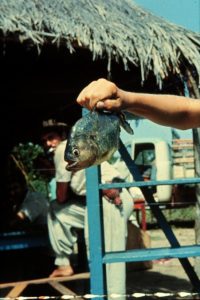
I don’t know who was more fearsome, the guy behind with his pistol and corn-husk cigarette or one of the Piranhas I caught. Photo by Rick Bein, 1964.
Nor was it easy getting the hook out of the piranha’s mouth. When I dangled the fish on the wire leader and hook, the piranha, in its fury, was still able to lunge upward and snap at my hand. I was terrified. I found out the locals left the hooks in the mouths until after the fish were cleaned, cooked, and served. The centerpiece of the lunch table was a bowl where the hooks were deposited.
Are piranhas good to eat? Richard, my Peace Corps colleague, thought they were good. I thought they were tough and bony with a fishy smell and taste. Because of all the tiny bones, they were fried to a crisp, giving them a pretzel-like crunchy texture. All I can say is, it was just as well that I was eating them rather than the other way around!
Thirty years later, my six-year-old son heard this story and said, “Dad, you were really lucky when you were swimming in that water!”
“No, Alex,” I said, “You were the lucky one!”

